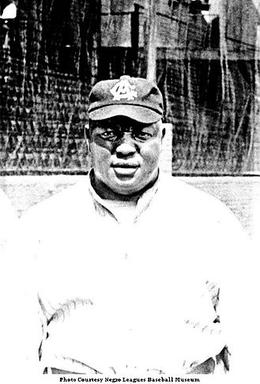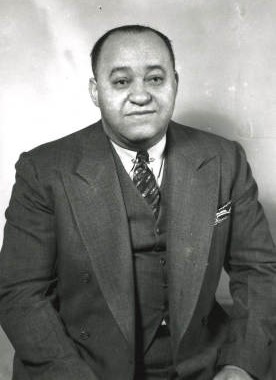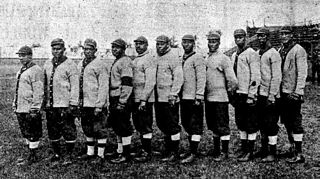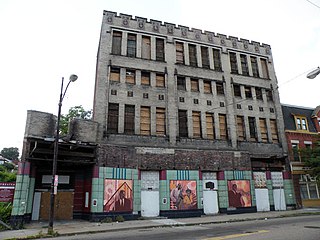Year-by-year record
| Year | Record | Finish | Manager | Notes |
|---|---|---|---|---|
| 1887 | 3-4 | -- | Walter Brown | League folded after 1 week |
| 1921 | 7-14-1 | 5th | Fred Downer | |
| 1922 | 14-23-2 | 6th | Dizzy Dismukes & Dicta Johnson |
| Pittsburgh Keystones | |
|---|---|
| Information | |
| League |
|
| Location | Pittsburgh, Pennsylvania |
| Ballpark |
|
| Year established | 1887 |
| Year disbanded | 1922 |
The Pittsburgh Keystones was the name of two historic professional Negro league baseball teams that operated in 1887 and again in 1921 and 1922. The first team was a member of the first black baseball league in 1887, the League of Colored Baseball Clubs. The league only lasted a week, which resulted in a 3-4 record for the Keystones, and included Weldy Walker, the second African-American to play in the major leagues and future hall of famer, Sol White. [1]
The second club was founded by Alexander McDonald Williams, a Barbadian immigrant and pool hall operator. [2] The Keystones' home field was Central Park, located in the Hill District at the corner of Chauncey Street and Humber Way. [3] The park was built by the prominent African American architect Louis Arnett Stuart Bellinger, who would later design Greenlee Field for the Pittsburgh Crawfords. [4] [5]
In their first season the Pittsburgh Keystones played as associate members of the Negro National League. Managed by Fred Downer, they compiled a 7-14-1 record against league and other associate clubs. [6] The Keystones joined the league as full members in 1922, finishing sixth with a 14-23-2 record in league play under managers Dizzy Dismukes and Dicta Johnson. [7] The team disbanded after the season.
| Year | Record | Finish | Manager | Notes |
|---|---|---|---|---|
| 1887 | 3-4 | -- | Walter Brown | League folded after 1 week |
| 1921 | 7-14-1 | 5th | Fred Downer | |
| 1922 | 14-23-2 | 6th | Dizzy Dismukes & Dicta Johnson |

Andrew "Rube" Foster was an American baseball player, manager, and executive in the Negro leagues. He was elected to the Baseball Hall of Fame in 1981.
The Pittsburgh Crawfords, popularly known as the Craws, were a professional Negro league baseball team based in Pittsburgh, Pennsylvania. The team, previously known as the Crawford Colored Giants, was named after the Crawford Bath House, a recreation center in the Crawford neighborhood of Pittsburgh's Hill District.
The Chicago American Giants were a Chicago-based Negro league baseball team. From 1910 until the mid-1930s, the American Giants were the most dominant team in black baseball. Owned and managed from 1911 to 1926 by player-manager Andrew "Rube" Foster, they were charter members of Foster's Negro National League. The American Giants won five pennants in that league, along with another pennant in the 1932 Negro Southern League and a second-half championship in Gus Greenlee's Negro National League in 1934.

William Augustus Greenlee was a highly successful businessman in Pittsburgh, Pennsylvania, who was born and raised in Marion, North Carolina. After migrating to Pittsburgh as a young man and working in the steel industry, he started to acquire his own businesses.
Greenlee Field in Pittsburgh, Pennsylvania, was one of only a few Black-built and Black-owned major league baseball fields in the United States. The field was the dream of Gus Greenlee, owner of the Pittsburgh Crawfords.
The Dayton Marcos were a Negro league baseball team based from Dayton, Ohio that played during the early twentieth century.
The New York Lincoln Giants were a Negro league baseball team based in New York City from 1911 through 1930.
The National Colored Base Ball League, the National Colored League, or the League of Colored Baseball Clubs was the subsequent attempt, after the Southern League of Colored Base Ballists, to have a league consisting of all-black teams. It predated Rube Foster's Negro National League by over three decades.
The Lincoln Stars were a Negro league baseball team that played in New York City from 1914 to 1917. Their home stadium was the Lenox Oval, located at Lenox Avenue and 145th Street in Manhattan. Although they lasted less than four years, they were a good team that featured three players who would later be elected to the National Baseball Hall of Fame—Oscar Charleston, John Henry Lloyd, and Louis Santop.
The American Series was a set of baseball games played between Cuban and American teams in Cuba. An American team would travel to Cuba and play various professional, all-star and/or amateur Cuban teams throughout the country. The series usually took place either in the fall, after the end of the American season, or during spring training before the season began. The first American Series took place in 1879, with then minor league Worcester team going 2–0 against its Cuban opponents.

Louis "Dicta" Johnson was an American spitball pitcher in Negro league baseball and during the pre-Negro league years. He played from 1908 until 1923, mostly for the Indianapolis ABCs and the Chicago American Giants.
The Long Branch Cubans were a professional baseball team that played from 1913 to 1916. It was the first U.S. minor league baseball team composed almost entirely of Cubans. Several players, including Dolf Luque and Mike González, went on to play in the major leagues. The Cubans played in Long Branch, New Jersey from 1913 to 1915, except for the first half of the 1914 season, when they played in Newark, New Jersey. In 1916, they started the season playing in Jersey City, New Jersey as the "Jersey City Cubans." Later that summer, they moved their home games to Poughkeepsie, New York, where they were usually referred to as the "Long Branch Cubans." In late July 1916 they briefly moved to Harlem and finally to Madison, New Jersey in August.
Central Park was a baseball venue located in the Hill District of Pittsburgh, Pennsylvania from 1921–1925. The stadium was the first black-owned, controlled and managed baseball park in the city.

Sellers McKee Hall was the first African-American music promoter to be based in Pittsburgh, Pennsylvania, as well as professional player and executive in Negro league baseball.
The Memphis Red Sox were an American Negro league baseball team that was active from 1920 to 1959. Originally named the Barber College Baseball Club, the team was initially owned and operated by Arthur P. Martin, a local Memphis barber. In the late 1920s the Martin brothers, all three Memphis doctors and businessmen, purchased the Red Sox. J. B. Martin, W. S. Martin, and B. B. Martin, would retain control of the club till its dissolution in 1959. The Red Sox played as members, at various times, of the Negro Southern League, Negro National League, and Negro American League. The team was never a titan of the Negro leagues like wealthier teams in northern cities of the United States, but sound management lead to a continuous thirty-nine years of operation, a span that was exceeded by very few other teams. Following integration the team had five players that would eventually make the rosters of Major League Baseball teams and two players that were inducted into the Baseball Hall of Fame.

Louis Arnett Stuart Bellinger was an American architect responsible for the design of significant buildings in and near Pittsburgh.
The Baltimore Lord Baltimores were a professional pre-Negro league baseball team based in Baltimore, Maryland in 1887. The Lord Baltimores played as charter members of the short–lived 1887 National Colored Base Ball League, hosting home games at Oriole Park.